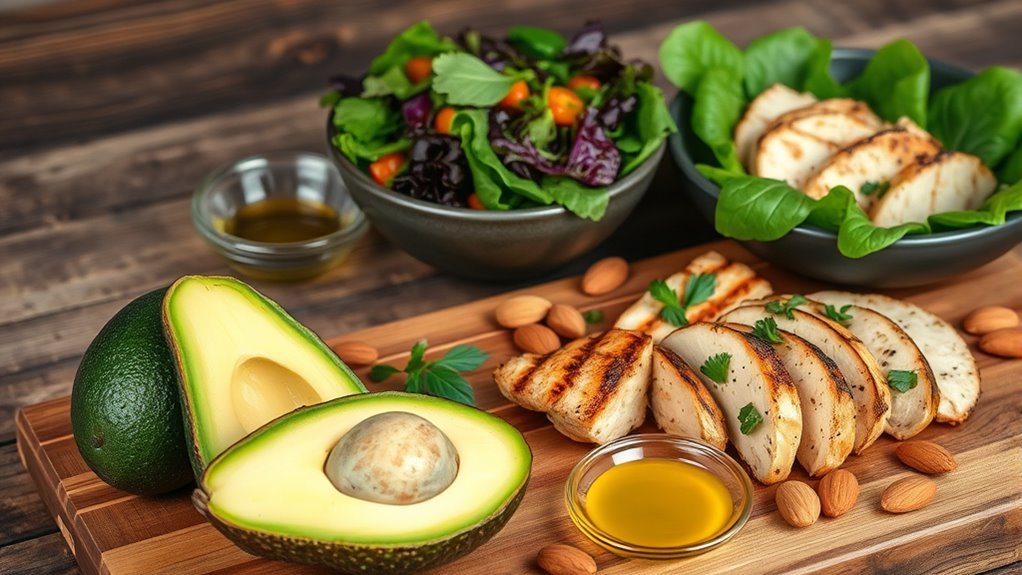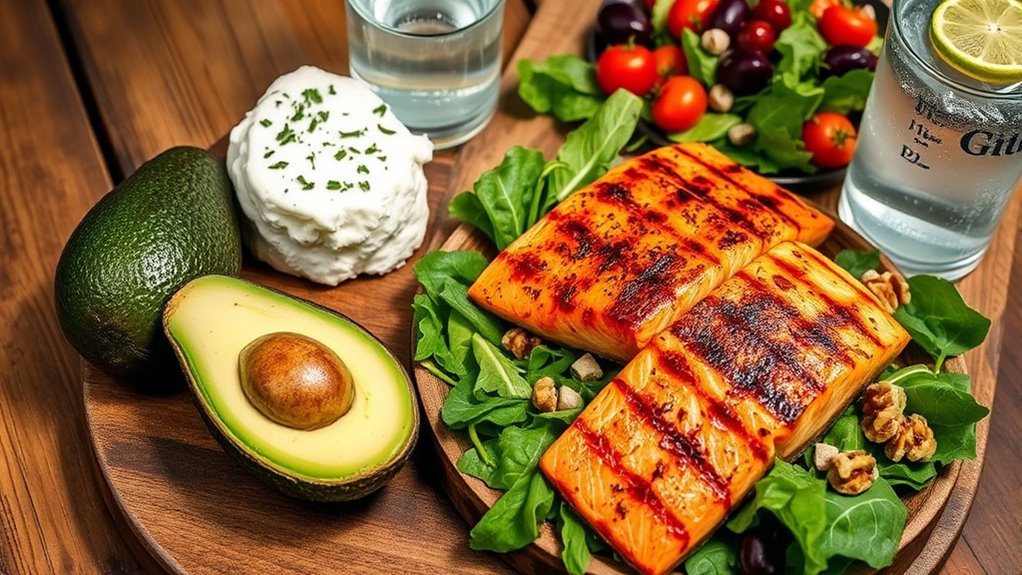Eating keto means following a dietary approach that emphasizes high fats, moderate protein, and very low carbohydrates. This change helps your body enter ketosis, where it burns fat for energy instead of carbs. You’ll likely experience benefits like weight loss, increased mental clarity, and stabilized energy levels. However, some challenges may arise during the transformation. If you want to know more about the science behind ketosis and how to embrace the keto lifestyle, there’s more to explore.
Understanding the Ketogenic Diet

When you’re exploring the ketogenic diet, it’s important to understand its foundational principles. The keto lifestyle emphasizes high-fat, moderate-protein, and low-carbohydrate intake, which shifts your body into a state of ketosis. In this state, your body burns fat for fuel rather than carbohydrates. Meal planning is essential for success; it helps you make informed choices that align with your goals. Incorporating healthy fats like avocados and nuts, along with quality proteins, is crucial. You’ll also want to avoid processed foods and sugars. By planning your meals, you empower yourself to embrace this lifestyle fully, ensuring you not only meet your nutritional needs but also achieve the freedom to enjoy diverse, delicious food while maintaining your health objectives.
The Science Behind Ketosis

When you enter ketosis, your body shifts from using carbohydrates for energy to burning fat instead. This metabolic change not only affects how you fuel your activities but also triggers hormonal changes that can impact appetite and energy levels. Understanding these processes can help you make informed choices about your ketogenic diet.
Ketosis Explained Simply
Ketosis is a metabolic state that occurs when your body shifts from using carbohydrates as its primary energy source to relying on fat. This change can lead to various ketosis benefits, such as increased fat burning and improved mental clarity. However, it’s important to separate ketosis myths from facts. Many believe that ketosis is unhealthy or unsustainable, but research indicates that, for most people, it can be a safe and effective way to manage weight and enhance metabolic health. By adopting a low-carb diet, you can encourage your body to enter ketosis. Embracing this state gives you the freedom to explore different eating patterns that align with your health goals while enjoying the benefits of fat as a fuel source.
Energy From Fat
The process of deriving energy from fat is a fascinating aspect of ketosis, where your body transforms stored fat into ketones—powerful molecules that fuel your brain and muscles. This shift in fat metabolism is key to understanding how energy production occurs on a ketogenic diet. When you reduce carbohydrate intake, insulin levels drop, prompting your body to tap into its fat reserves. As fat breaks down, it generates ketones, which serve as a more efficient energy source for many cells. This metabolic adaptation not only helps with weight loss but also enhances mental clarity and physical endurance. Embracing this state can lead to a newfound sense of freedom, as your body becomes adept at utilizing its own fat for energy.
Hormonal Changes Impact
As your body enters ketosis, significant hormonal changes occur that play a crucial role in this metabolic state. These changes are essential for achieving hormonal balance and supporting your body’s adaptation to burning fat for fuel. Key hormones like insulin and glucagon shift, influencing your metabolic changes and fat storage.
| Hormone | Effect in Ketosis | Impact on Body |
|---|---|---|
| Insulin | Decreases | Promotes fat burning |
| Glucagon | Increases | Stimulates fat release |
| Cortisol | May rise or stabilize | Affects stress response |
Understanding these hormonal shifts can empower you to harness the benefits of ketosis, allowing for a more liberated approach to your dietary choices. Embrace the freedom that comes with balanced hormones!
Key Components of a Keto Diet

To successfully follow a keto diet, you’ll need to focus on high-fat foods and limit your carbohydrate intake considerably. This approach aims to induce nutritional ketosis, where your body shifts from using glucose as its primary energy source to burning fat instead. Understanding these key components can help you navigate your journey towards achieving and maintaining ketosis effectively.
High-Fat Foods
While commencing a keto diet, understanding the role of high-fat foods is essential for achieving and maintaining ketosis. Incorporating healthy fats can keep you energized and satisfied. Here are some key options to examine:
- Avocado benefits: Packed with fiber and potassium, they support heart health.
- Cheese varieties: From cheddar to goat cheese, they add flavor and protein.
- Fatty fish: Rich in omega-3s, they promote brain health.
Don’t forget about nut options, coconut oil, and olive oil for cooking. Butter types and cream sources can elevate your meals, while keto snacks like cheese crisps provide quick energy. By embracing these foods, you’ll enjoy the freedom of delicious meals while thriving on your keto journey.
Low-Carb Choices
Choosing low-carb options is essential for maintaining the state of ketosis that the keto diet aims for. By focusing on low-carb snacks and healthy alternatives, you can better control your carbohydrate intake while enjoying a variety of flavors. Some great options include nuts, cheese, and certain vegetables like cucumbers and bell peppers. These choices not only fit within your carb limits but also provide essential nutrients. Instead of reaching for traditional snacks, consider whipping up kale chips or guacamole paired with celery sticks. Embracing these low-carb alternatives gives you the freedom to satisfy your cravings without derailing your diet. With thoughtful planning, you can enjoy delicious snacks while staying committed to your keto journey.
Nutritional Ketosis
Nutritional ketosis is a metabolic state that plays an essential role in the keto diet, allowing your body to efficiently burn fat for fuel instead of carbohydrates. This shift not only supports weight loss but also offers numerous nutritional benefits, enhancing your overall health. As you embrace this lifestyle, you’ll experience metabolic adaptation, which helps your body become more efficient at using fat as energy.
- Increased energy levels and mental clarity
- Reduced cravings and hunger pangs
- Enhanced fat loss and improved body composition
Benefits of Eating Keto
As you explore the benefits of eating keto, you’ll find that this low-carbohydrate diet can lead to significant weight loss, improved energy levels, and enhanced mental clarity. Many people experience keto weight loss due to reduced insulin levels and increased fat burning. This shift not only helps you shed pounds but also stabilizes your energy, allowing you to avoid the dreaded sugar crashes. Additionally, the keto diet has been linked to better brain health, as ketones can serve as a more efficient fuel source for your brain. Studies suggest it may even improve focus and cognitive function, giving you the mental freedom to tackle daily challenges. By embracing keto, you’re opting for a lifestyle that promotes both physical and mental well-being.
Potential Challenges and Considerations
While the keto diet offers numerous benefits, it’s essential to recognize the potential challenges and considerations that come with it. You might experience keto cravings as your body adjusts to low-carb living, making it tough to stay committed. Additionally, the restrictive nature of the diet can lead to nutrient deficiencies, especially if you don’t plan meals carefully.
- Emotional rollercoaster with cravings
- Fear of missing out on social meals
- Struggle against fatigue and low energy
It’s important to monitor your health and consider supplementation to combat these issues. By staying informed and proactive, you can navigate the challenges of keto while still enjoying its many freedoms. Embrace the journey, but be mindful of these hurdles along the way.
How to Get Started on Keto
Getting started on the keto diet can feel intimidating, but with a clear plan and some preparation, you can ease into this low-carb lifestyle. Begin by focusing on meal planning; outline your weekly meals to guarantee you stay within your carb limits. Look for recipes that highlight healthy fats, moderate protein, and low-carb vegetables. Next, tackle grocery shopping. Make a list of keto-friendly foods like avocados, nuts, and leafy greens to avoid impulse buys. Don’t forget to check labels for hidden sugars. It’s also helpful to prepare snacks in advance, so you’re never caught off guard. By organizing your meals and shopping smartly, you’ll set yourself up for success and enjoy the freedom that comes with a keto diet.
Common Misconceptions About Keto
What misconceptions might you have about the keto diet? Many people fall prey to keto myths that can cloud their understanding. Here are a few common diet misconceptions:
- Keto means eating unlimited bacon and cheese.
- It’s a quick-fix solution, not a sustainable lifestyle.
- You’ll miss out on essential nutrients.
In reality, keto encourages a balanced approach with whole foods, emphasizing vegetables and healthy fats. It’s not just about cutting carbs; it’s about fueling your body efficiently. By debunking these myths, you can embrace the freedom that comes with informed choices, allowing you to thrive on keto without fear or restriction. Understanding the truth behind these misconceptions is key to achieving your health goals.


